|











|
 |
During the next several thousand years, many peoples from
southwest and central Asia came into the region that is now
Pakistan. About 1500 B.C., a central Asian people called
Aryans came through the mountain passes to the Punjab
region. In time, they settled across almost all of India. The
Persians conquered the Punjab during the 500's B.C., and
made it part of he huge Acheamenid Empire. In 326 B.C.,
Alexander the Great took control of most of what is now Pakistan.
A few years later, the emperor Chandragupta Maurya made the
region part of the Maurya
Empire. |
The Maurya Empire began to break up about 230 B.C., Greeks from
the independent state of Bactria in central Asia then invaded the
Indus Valley. They established a kingdom with capitals near the present-day
cities of Peshawar and Rawalpindi. About 100 B.C., Scythians from
Afghanistan came into Baluchistan and Sindh. In time, they conquered
the Indus region. The Aghans were replaced by Parthians, who, in turn,
were conquered by Kushans of central Asia. The Kushans ruled what
is now Afghanistan, Pakistan, and northwestern India form about A.D.
50 to the mid 200's. They controlled the trade routes from China to
India and the Middle East. Peshawar, the Kushan capital, became a
major commercial center. During the mid-300's, the Indus Valley became
part of the Gupta Empire, which had expanded westward from the empire
in the mid-400's.
Back on
top
The Coming Of
Islam
 |
In A.D. 712, When trade
of Arab in the Indian ocean was jeopardized by sea pirates,
Muhammad Bin Qasim, led a naval expedition to subdue the ruler of
Sindh, Raja Dahir. Muhammad Bin Qasim, in conformity of
Muslim practice, guaranteed the security and freedom of
life, property and worship to the conquered people.
|
 |
Beginning about A.D. 1000, Turkish Muslims invaded northern
Pakistan from Iran. Mahmud of Ghazni led as many as seventeen
expedition, but the only permanent result of his expeditions
was the conquest of Punjab. The Turkish ruler Mahmud of
Ghazni established a Muslim Kingdom that in time included the
entire Indus Valley. Lahore became the capital of the kingdom and
developed into a major center of Muslim culture. In 1206,
most of what is now Pakistan, became part of the
Delhi Sultanate, a Muslim ruler from Afghanistan,
invaded India and established the Mogul
Empire. |
Back on
top
The Mogul Empire
 |
The Mogul Empire included almost all of what is now
Pakistan, India, and Bangladesh. Under Mogul rule, a culture
developed that combined Middle Eastern and Indian elements. It
included a new language, Urdu, which was influenced by
Arabic and Persian. The Mogul Empire began to decline in the
1700's.Several groups, including Persians and Afghans, then
controlled the region that is
Pakistan. |
Back on top
The Rise of British
Influence
Beginning in the 1500's, European traders competed for
control of the profitable trade between Europe an the East Indies. A
number of trade companies established settlements in India with the
cooperation of the Mogul emperors. By the 1700's, the British
East India Company had become the strongest trade power in India. In
the 1740's, after the Mogul Empire began to break up, the East
India Company gained political control over much of India. The company
fought a series of wars in the Punjab and Sindh during the 1840's
and added these territories to its holdings. The British government
took over control of the East India Company in 1858.All the
company's territory then became known as British India. By 1900,
as a result of wars and treaties with local rulers, British India
included all of what is now Pakistan.
Go to top
The British
Control
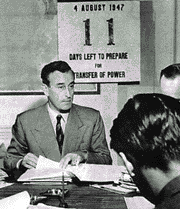 |
Britain introduced a number of reforms in India, including
the establishment of a Western system of education. Many Hindus
enrolled in the British schools, but Muslims did not attend the
British Schools. Large numbers of Hindus gained positions in
business and government. In 1875, Syed Ahmad Khan, a Muslim
leader, founded the Muhammadan Angio-Oriental College in
Aligarh. This school combined Muslim and Western methods of
education. Many of its graduates became leaders of India's Muslim
community.
| Muslim leaders were divided in their attitude about
the Hindus. Some believed that Muslims should cooperate with Indian
National Congress, a political organization led by Hindus. But most
Muslims thought that if the congress gained power, it would never treat
the Muslims fairly. In 1906's, the Muslims formed a separate
political organization called the Muslim
League.
Go to top
Independence
Movements
 |
Independence movements in India began to gain strength
during the early 1900's. The Muslim League and Indian
National Congress both sought greater self-government for India.
But at the same time, differences between the Hindus and Muslims
increased. Al most all the Muslims believed the Hindus would have
too much power over them if India gained independence from
Britain. In the early 1930's, the Muslim League called for
the creation of a separate Muslim nation. Such a nation would have
been formed from the parts of India that had a Muslim majority.
The president of the Muslim League, Muhammad Ali Jinnah,
became a leading supporter of this proposal. The Name Pakistan,
which means land of pure. In 1940, the Muslim League
demanded division of India along religious lines. British and
Hindu leaders rejected the idea, but the league refused any other
settlement. | Riots occurred, in the result of injustice of Hindus and British
for Muslims. in 1947, Britain leaders finally agreed to the
partition. The Muslims of India worked hard to get Pakistan, due to
efforts of Muslims of Sub continent to get their own country, Hindus
also got India. In 1947,British divided the sub continent
according to the religion of its people.
Back on
top
The New Nation,
PAKISTAN
 |
On August. 14,1947, Pakistan became an
independent dominion in the commonwealth of Nations. The country's
official name is the Islamic Republic of Pakistan. About
97% of its people practice Islam, the Muslim religion.
Religion was the major reason for the establishment of Pakistan as
an independent nation. Pakistan was created from
the | northwestern and northeastern parts of India,
where Muslims made up the majority of the population. More than 1,000
miles ( 1,600 kilometers ) of Indian territory lay between the two
sections, which were called West Pakistan and East Pakistan. Muhammad
Ali Jinnah, considered the founder of Pakistan, became the first
head of government.
Back on
top
Land Area
 |
The land area of Pakistan is 796,095 sq km (307,374 sq mi
) .K2 is the highest point of Pakistan, also called Mount
Godwin-Austen 6811 m (28,251 ft) above sea level. Sea level is
the lowest point of
Pakistan. |
Back on top
Population
 |
The ethnological
background of the population of Pakistan is extremely varied,
largely because the country lies in an area that was invaded
repeatedly during its long history. The population of Pakistan
(1997 estimate) is 132,185,328, yielding an average population
density of 166 persons per sq km (430 per sq mi). The
country's population was increasing in 1997 at a rate of 2.2
percent a year. | The population is expected
to reach 150 million by the year 2000.Of the four provinces, with
25.8 percent of land area of the country, Punjab has 56.5
percent of the total population; Sindh, with 17.7 percent of
land area, has 22.6 per cent: NWFP, (including FATA) with 12.8
percent of land area, has 15.7 percent; Baluchistan, with
43.6 percent of land area, has 5.1 percent. Punjab is the
most densely (240 persons per sq km) populated province, followed
by Sindh and NWFP. Baluchistan is the least populated province,
with 19 persons per square kilometer. Age Composition According
to the Labour Force Survey, 1990-91, 46.93 of the
population is under 15 years of age; 49.66 percent is between the
age groups of 15 and 64 years, while 3.41 percent
comprises persons 65 years old and above.
Back on
top
Pakistan's Weather
|
|
The climate of Pakistan varies widely from place to place.
In the mountain regions of the north and west, temperatures fall
below freezing during winter; in the Indus Valley area,
temperatures range between about 32° and 49° C (about 90° and
120° F) in summer, and the average in winter is about13° C
(about 55° F). Throughout most of Pakistan rainfall is scarce.
The Punjab region receives the most precipitation, more than
500 mm (more than 20 in) per year. The arid regions of the
southeast and southwest receive less than 125 mm (less than 5
in) annually. Most rain falls in July and
August.
| Back on top
Capital City of
Pakistan
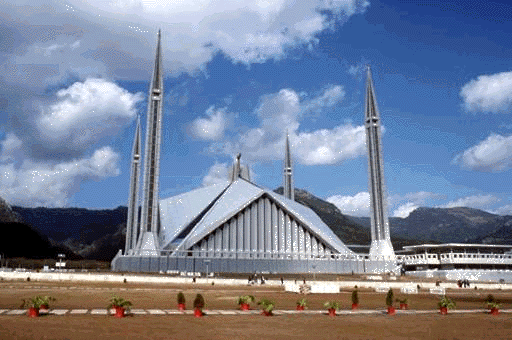 |
After the division of sub continent, Karachi was the
Capital City of Pakistan. But in 1959 Islamabad
designated to replace Karachi as Pakistan's Capital and was
built during the 1960's.Islamabad lies at the base of the
Margalla Hills adjacent to Rawalpindi, Punjab, on the north side.
In relatively short span, Islamabad has become one of the most
impressive capitals in the world, exuding hope and confidence in
Pakistan's future. | It is divided into
several sectors. To create a natural atmosphere a jungle has been left
in the center of the city. Moreover, Shah Faisal Mosque which is
one the most beautiful mosques in the world, makes Islamabad more
beautiful. All the government buildings are of most modern in design and
construction.
Back on
top
Pakistani
Flag
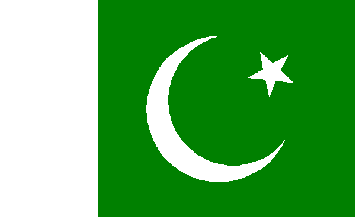 |
The Pakistan Flag was designed by
Quaid-i-Azam Muhammad Ali Jinnah, the founder of Pakistan.
Pakistani flag has a star and crescent, traditional
symbols of Islam. There are two colors in the flag of
Pakistan, green and white. The green color stands for
the nation's
Muslim majority and
white color is for the non-Muslims in Pakistan. The creasing
on the flag represent the | progress and the five rayed
star on the flag represents the light and knowledge.
Back on
top
Pakistani
Language
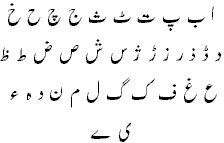 |
Pakistani official
language is Urdu. But less than one-tenth people use it as
their first language. Scholars say that it developed in the Punjab
and neighboring territories about one thousand years ago.Urdu
contains many words of Arabic and Persian and the words of many
other languages. Urdu language is written from right to left. Urdu
is spoken in many countries of the World. Urdu contains 34
Alphabetic. The word Urdu is of Turkish origin and means
'army' or 'camp'. So Urdu is, quite simply, the language of
the camp. Click
Here to read Urdu's history. | (The urdu alphabets lack few
characters. Due to huge load of studies, The mistake could not be
fixed.I aplogize for any inconvenience.)
Back on top
National
Anthem
 |
Pakistani
National Anthem was approved in june,1954, composed by
Abul Asar Hafeez Jullundhri and tune composed by Ahmed G.
Chagla and the duration of Pakistani National Anthem is 80
seconds. Pakistan national anthem is a harmonious rendering of
a three-stanza composition with a tune based on eastern
music but arranged in such a manner that it can be easily played
by foreign bands. Here the national anthem is in Urdu and also you
can read its translation in English:
Blessed be the
sacred Land
Happy be the bounteous realm
Symbol of high
resolve
Land of Pakistan
Blessed be thou citadel of
faith
The order of this sacred land
Is the might of the
brotherhood of the People
May the nation, the country, and the
state
Shine in glory everlasting
Blessed be the goal of our
ambition
This Flag of the Crescent and Star
Leads the
way to progress and perfection
Interpreter of our past, glory
of our present
Inspiration of our future
Symbol of
Almighty's protection
|
Back on
top
Religion
| Islam
is not only the
national religion of Pakistan but it is also a universal
religion. The followers of Islam are called Muslims. If you want
to know about Islam, Please use the pak links or Islam page from
the main page of my site. |
Back on top
Provinces
Pakistan is divided into four provinces
(Baluchistan, North-West Frontier Province, Punjab, and Sindh).
Karachi is the capital of Sindh, Lahore is of Punjab,
Peshawar is of Frontier and, Quetta is of Baluchistan.
Back on
top
Major
Cities
 |
Pakistan's largest city is Karachi. Other significant urban
centers are Lahore, an industrial center; Faisalabad, a center
of the cotton industry; Rawalpindi, an industrial city; Hyderabad,
a manufacturing center; Multan; and Peshawar, a hub of trade with
Afghanistan. Islamabad is the capital of
Pakistan. |
Back on top
Army
 |
Pakistani Army is considered one of the best defense
in the world. In 1996 the country's armed forces had 587,000
members, including 45,000 in the air force and 22,000 in
the navy. Another 247,000 were in paramilitary units.
Pakistan army has fought two major wars in 1965 and in
1971. |
Back on
top
National
Government
 |
Pakistan's Constitution was adopted
in 1973. A prime minister heads the country's government.
The prime minister appoints a Cabinet that assists the prime
minister. A president serves as Pakistan's head of state. Most of
the president's duties are ceremonial. The parliament consists of
a National Assembly and Senate. Most members of
the | National Assembly are elected by the people.
Most senators are elected by provincial assemblies. The recent Chief
Executive of Pakistan is General Pervez Musharraf Nishan-I-Imtiaz
(Military),Tamgha-i-Basalat while the Mir Zafarullah Khan Jamali
is the Prime Minister.
Back on
top
Provincial
Government
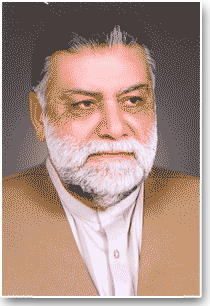 |
Pakistan is divided into four
provinces_Baluchistan, North-West Frontier Province (NWFP), the
Punjab, and Sindh. An elected assembly governs each
province. |
Back on
top
Local
Government
Elected and appointed
officials govern cities, towns, and villages. Islamabad, the nation's
capital, is governed by the central government as a separate district
called the Capital Territory of Islamabad. Certain parts of
Pakistan that border Afghanistan are Tribal Territories. The central
government has authority over these territories, but members of the
various tribal groups handle most of their own governmental
affairs.
Back on
top
Sports
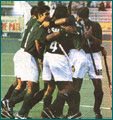 |
Pakistan's
National game is hockey but cricket is more favorite
than any other game. Pakistan is World Champion in Hockey,
Cricket, Squash, and Snooker. Pakistan has the best players of the
world in these games. |
Back on top
Education
Only 38 percent of adult Pakistanis are literate. The constitution
prescribes free primary education. While enrollment rate in primary
school in high for boys, less than one-half of girls attend school.
Five years has been established as the period of primary school
attendance. in the 1993-1994 school year 15.5 million
pupils were enrolled in pre primary and primary schools, and
5.0 million students attended secondary schools. In the
early 1990s, 336,600 students attended institutions of
higher education. There are an estimated: 300 secondary
professional institutes, 600 liberal arts, professional, teacher
training colleges., 30 universities (most of them co-educational)
in Pakistan.
Back on top


This site is created and maintained by Sarah
Qureshi
All rights reserved. Copy Rights © 2000 - 2003
|

![]()
![]()